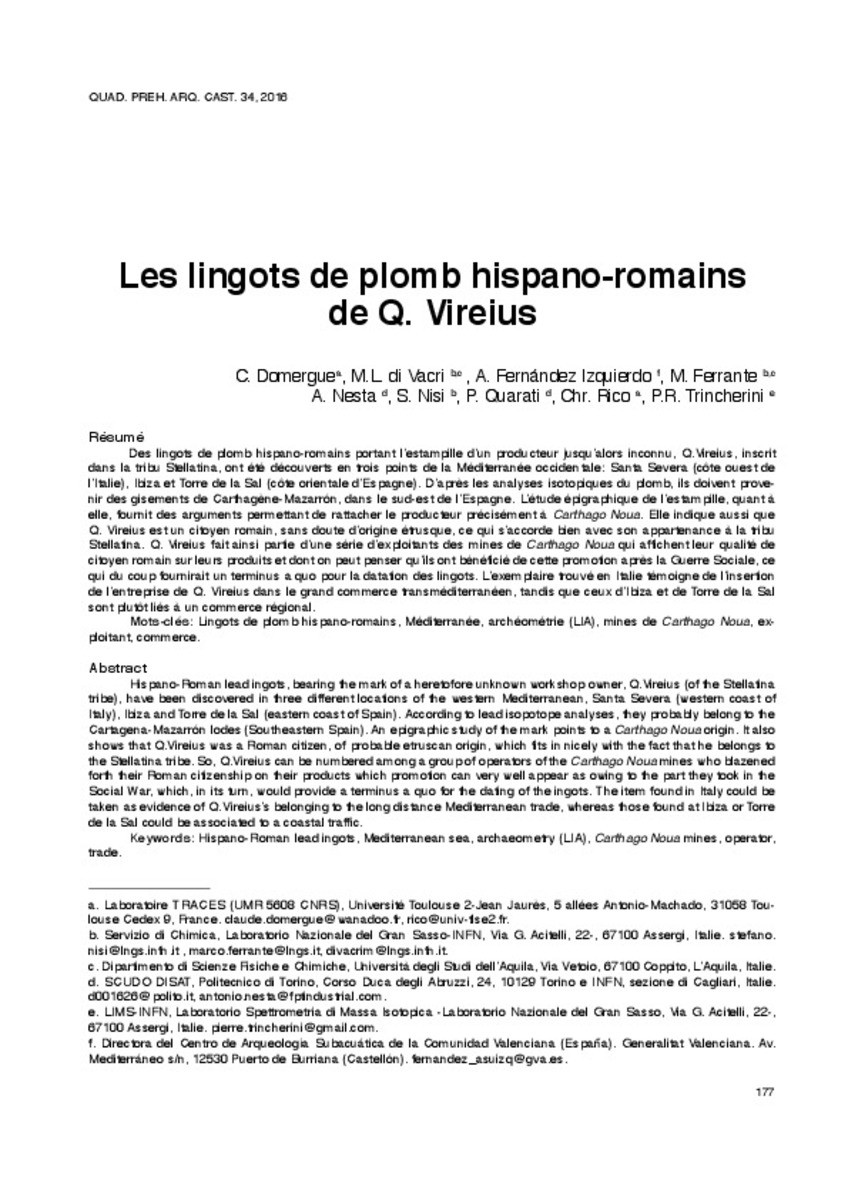Mostrar el registro sencillo del ítem
Les lingots de plomb hispano-romains de Q. Vireius
| dc.contributor.author | Domergue, C. | |
| dc.contributor.author | di Vacri, M.L. | |
| dc.contributor.author | Fernández Izquierdo, Asunción | |
| dc.contributor.author | Ferrante, M. | |
| dc.contributor.author | Nesta, A. | |
| dc.contributor.author | Nisi, S. | |
| dc.contributor.author | Quarati, P. | |
| dc.contributor.author | Rico, Chr. | |
| dc.contributor.author | Trincherini, P.R. | |
| dc.date.accessioned | 2017-02-17T12:46:37Z | |
| dc.date.available | 2017-02-17T12:46:37Z | |
| dc.date.issued | 2016 | |
| dc.identifier.citation | DOMERGUE, C. , et al. Les lingots de plomb hispano-romains de Q. Vireius. Quaderns de Prehistòria i Arqueologia de Castelló, 2016, vol. 34, p. 177-196 | ca_CA |
| dc.identifier.issn | 1137-0793 | |
| dc.identifier.uri | http://hdl.handle.net/10234/166147 | |
| dc.description.abstract | Des lingots de plomb hispano-romains portant l’estampille d’un producteur jusqu’alors inconnu, Q.Vireius, inscritdans la tribu Stellatina, ont été découverts en trois points de la Méditerranée occidentale: Santa Severa (côte ouest de l’Italie), Ibiza et Torre de la Sal (côte orientale d’Espagne). D’après les analyses isotopiques du plomb, ils doivent provenir des gisements de Carthagène-Mazarrón, dans le sud-est de l’Espagne. L’étude épigraphique de l’estampille, quant à elle, fournit des arguments permettant de rattacher le producteur précisément à Carthago Noua. Elle indique aussi que Q. Vireius est un citoyen romain, sans doute d’origine étrusque, ce qui s’accorde bien avec son appartenance à la tribu Stellatina. Q. Vireius fait ainsi partie d’une série d’exploitants des mines de Carthago Noua qui affichent leur qualité de citoyen romain sur leurs produits et dont on peut penser qu’ils ont bénéficié de cette promotion après la Guerre Sociale, ce qui du coup fournirait un terminus a quo pour la datation des lingots. L’exemplaire trouvé en Italie témoigne de l’insertion de l’entreprise de Q. Vireius dans le grand commerce transméditerranéen, tandis que ceux d’Ibiza et de Torre de la Sal sont plutôt liés à un commerce régional. | ca_CA |
| dc.description.abstract | Hispano-Roman lead ingots, bearing the mark of a heretofore unknown workshop owner, Q.Vireius (of the Stellatina tribe), have been discovered in three different locations of the western Mediterranean, Santa Severa (western coast of Italy), Ibiza and Torre de la Sal (eastern coast of Spain). According to lead isopotope analyses, they probably belong to the Cartagena-Mazarrón lodes (Southeastern Spain). An epigraphic study of the mark points to a Carthago Noua origin. It also shows that Q.Vireius was a Roman citizen, of probable etruscan origin, which fits in nicely with the fact that he belongs to the Stellatina tribe. So, Q.Vireius can be numbered among a group of operators of the Carthago Noua mines who blazened forth their Roman citizenship on their products which promotion can very well appear as owing to the part they took in the Social War, which, in its turn, would provide a terminus a quo for the dating of the ingots. The item found in Italy could be taken as evidence of Q.Vireius’s belonging to the long distance Mediterranean trade, whereas those found at Ibiza or Torre de la Sal could be associated to a coastal traffic. | ca_CA |
| dc.format.extent | 20 p. | ca_CA |
| dc.format.mimetype | application/pdf | ca_CA |
| dc.language.iso | fra | ca_CA |
| dc.publisher | Servei d’Investigacions Arqueològiques i Prehistòriques | ca_CA |
| dc.relation.isPartOf | Quaderns de Prehistòria i Arqueologia de Castelló, 2016, vol. 34 | ca_CA |
| dc.rights.uri | http://rightsstatements.org/vocab/CNE/1.0/ | * |
| dc.subject | lingots de plomb hispano-romains | ca_CA |
| dc.subject | Méditerranée | ca_CA |
| dc.subject | archéométrie (LIA) | ca_CA |
| dc.subject | mines de Carthago Noua | ca_CA |
| dc.subject | exploitant | ca_CA |
| dc.subject | commerce | ca_CA |
| dc.subject | Hispano-Roman lead ingots | ca_CA |
| dc.subject | Mediterranean sea | ca_CA |
| dc.subject | archaeometry (LIA) | ca_CA |
| dc.subject | Carthago Noua mines | ca_CA |
| dc.subject | operator | ca_CA |
| dc.subject | trade | ca_CA |
| dc.title | Les lingots de plomb hispano-romains de Q. Vireius | ca_CA |
| dc.type | info:eu-repo/semantics/article | ca_CA |
| dc.rights.accessRights | info:eu-repo/semantics/openAccess | ca_CA |
Ficheros en el ítem
Este ítem aparece en la(s) siguiente(s) colección(ones)
-
Any 2016 - Núm. 34 [17]







